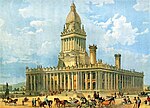The Met Hotel
Grade II listed buildings in LeedsGrade II listed hotelsHotel buildings completed in 1899Hotels established in 1899Hotels in Leeds ... and 4 more
Leeds Blue PlaquesUnited Kingdom listed building stubsUse British English from March 2017Yorkshire building and structure stubs

The Met Hotel is a Grade II listed building situated on King Street in Leeds, West Yorkshire, England. Designed by Leeds-based architects Harry Sutton Chorley and J.W. Connon, the hotel opened in 1899 as the Hotel Metropole. The Principal Hayley Group renovated the hotel in 2005, at a cost of £6 million, and changed the name to the trendier sounding 'The Met'. It has four stars and it has 120 rooms. The Hotel Metropole is a listed building, principally because of its rare and remarkable Victorian terracotta facade. The cupola on the roof was taken from the demolished 4th White Cloth Hall, built in 1868 on the same site.
Excerpt from the Wikipedia article The Met Hotel (License: CC BY-SA 3.0, Authors, Images).The Met Hotel
King Street, Leeds Holbeck Urban Village
Geographical coordinates (GPS) Address Nearby Places Show on map
Geographical coordinates (GPS)
| Latitude | Longitude |
|---|---|
| N 53.797111111111 ° | E -1.5506388888889 ° |
Address
Bank of England
King Street
LS1 2HH Leeds, Holbeck Urban Village
England, United Kingdom
Open on Google Maps









